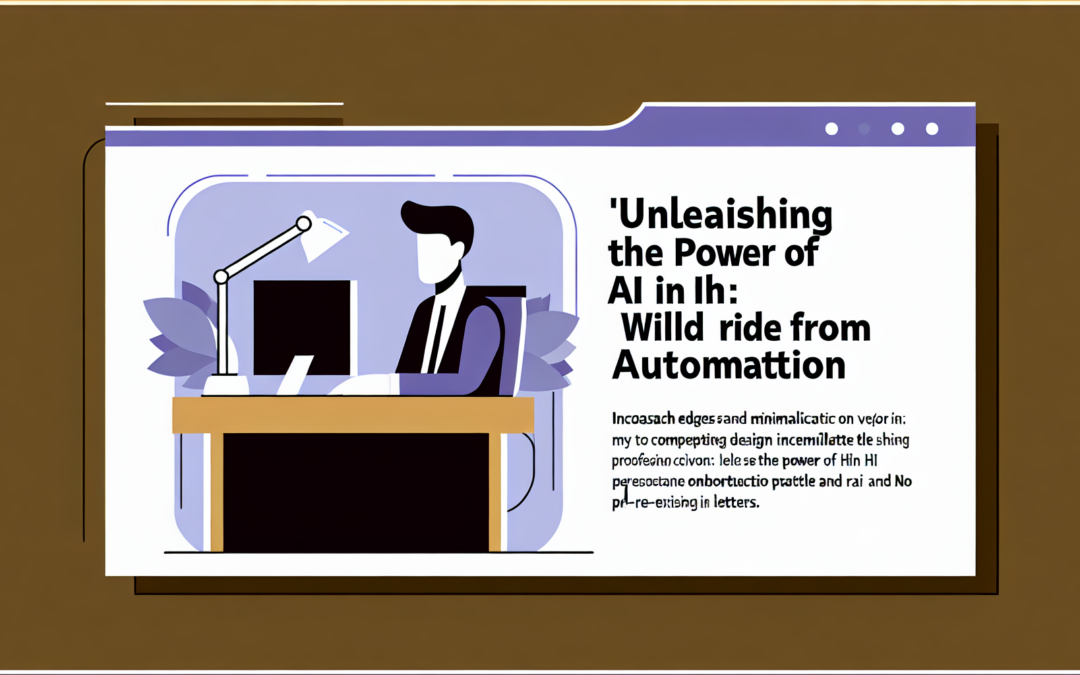Alright, folks, buckle up because we’re diving headfirst into the world of AI automation in HR. It’s like strapping a rocket to your HR processes and watching them zoom into the future. But, hey, don’t worry if you’re feeling a bit overwhelmed. We’re going to break it down step-by-step, so you can integrate AI into your HR like a pro. Let’s get this show on the road!
Understanding the Basics of AI in HR
First things first, let’s talk about what AI in HR even means. It’s not just about robots taking over your job (phew!). It’s about using smart algorithms and data-driven insights to make your HR processes smoother, faster, and, dare I say, cooler. Imagine having a personal assistant who never sleeps, never complains, and always has the latest data at their fingertips. That’s AI for you.
AI can help with everything from recruitment to employee engagement. It’s like having a Swiss Army knife for your HR department. Need to sift through a mountain of resumes? AI’s got your back. Want to predict which employees might be thinking of jumping ship? AI can do that too. It’s all about using technology to make better decisions and free up your time for the stuff that really matters.
But, of course, it’s not all sunshine and rainbows. There are challenges too. Like, how do you make sure your AI isn’t biased? Or how do you get your team on board with this newfangled technology? These are the questions we’ll tackle as we go along. So, stick with me, and we’ll navigate this AI journey together.
Identifying HR Processes for Automation
Now that we’ve got a handle on what AI can do, let’s talk about where to start. Not every HR process is ripe for automation, and that’s okay. The key is to identify the ones that are. Think about the tasks that are repetitive, time-consuming, and, frankly, a bit of a drag. Those are your prime candidates for automation.
Take recruitment, for example. It’s a beast of a process, with resumes to review, interviews to schedule, and candidates to evaluate. AI can help streamline this by using algorithms to screen resumes, schedule interviews, and even conduct initial assessments. It’s like having a recruitment team that works 24/7 without ever needing a coffee break.
But don’t stop there. Think about onboarding, performance management, and even payroll. These are all areas where AI can make a big impact. The trick is to start small, test the waters, and then expand as you get more comfortable. It’s like dipping your toes in the pool before diving in headfirst.
Choosing the Right AI Tools
Alright, so you’ve figured out which processes to automate. Now comes the fun part: choosing the right tools. It’s like being a kid in a candy store, but instead of sweets, you’ve got a plethora of AI tools to choose from. The key is to find the ones that fit your needs and budget.
Start by doing your homework. Research different AI tools, read reviews, and maybe even try out a few demos. Look for tools that are user-friendly, scalable, and have a good track record. You don’t want to end up with a tool that’s more trouble than it’s worth.
And don’t forget about integration. Your AI tools need to play nice with your existing systems. It’s like introducing a new friend to your group; you want them to get along with everyone. So, make sure your chosen tools can integrate seamlessly with your HR software and other systems.
Implementing AI in Your HR Department
You’ve got your tools, you’ve got your processes, now it’s time to implement. This is where the rubber meets the road, and things can get a bit tricky. But don’t worry, I’ve got some tips to help you navigate this part of the journey.
First, get your team on board. Change can be scary, and not everyone will be thrilled about the idea of AI taking over. So, communicate clearly, address concerns, and provide training. Make sure everyone knows how to use the new tools and understands the benefits.
Next, start small. Implement AI in one area first, see how it goes, and then expand. It’s like learning to ride a bike; you start with training wheels before going full speed. Monitor the results, gather feedback, and make adjustments as needed.
Measuring the Impact of AI Automation
Once your AI systems are up and running, it’s time to measure their impact. After all, you want to know if all this effort is paying off, right? Look at metrics like time saved, cost reductions, and employee satisfaction. These will give you a good idea of how well your AI automation is working.
But don’t just rely on numbers. Talk to your team, get their feedback, and see how they feel about the changes. Sometimes, the human element is just as important as the data. And remember, AI is a tool, not a magic wand. It’s there to help, not to replace the human touch.
So, there you have it. A whirlwind tour of integrating AI automation in HR. It’s a journey full of twists and turns, but with the right approach, it can be a game-changer for your department. So, go forth and embrace the future of HR!

